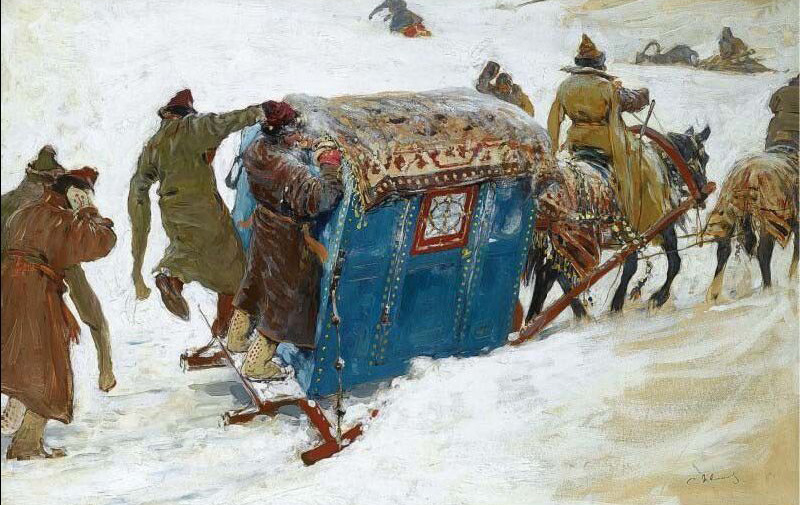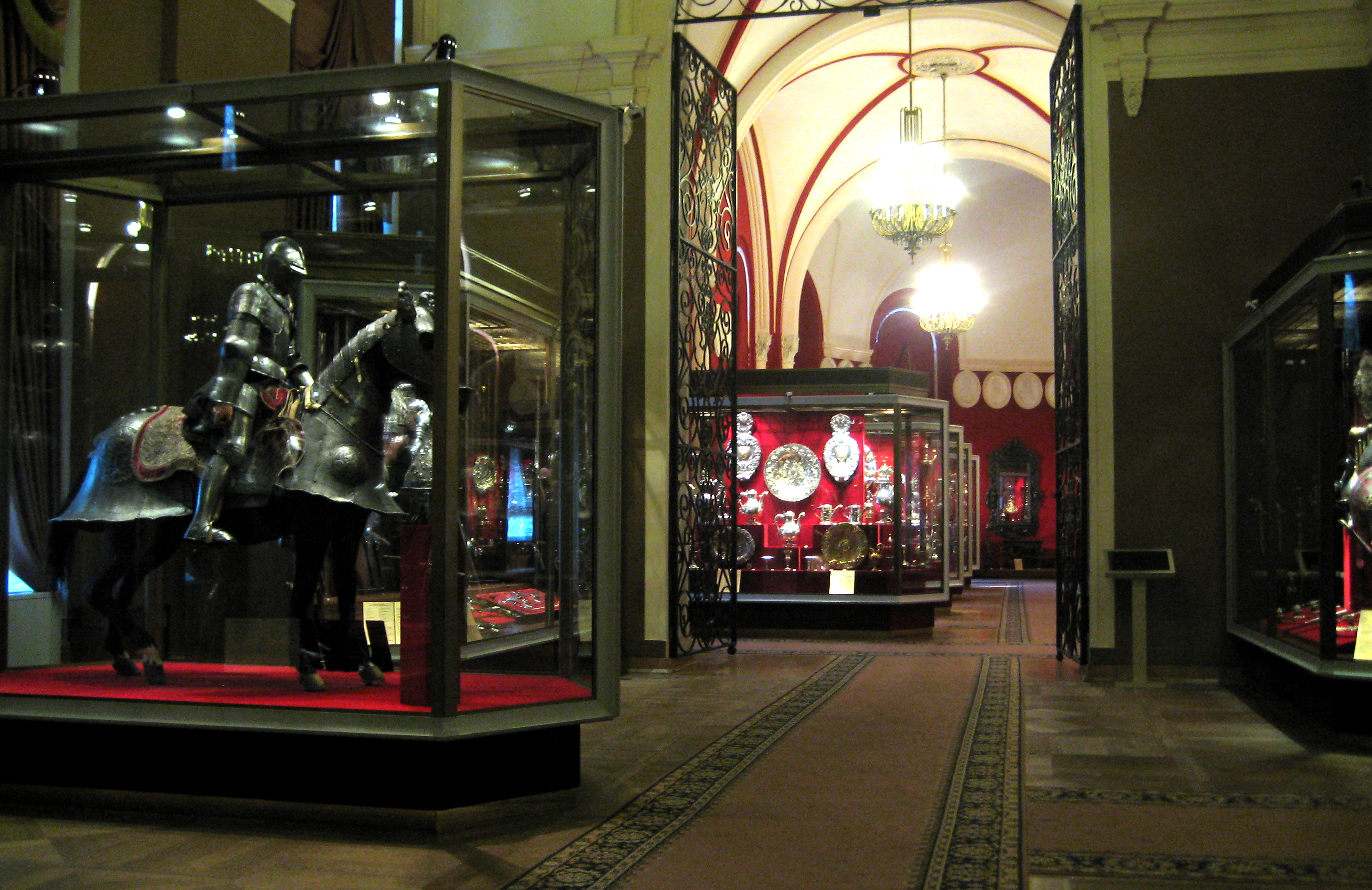|
Vozok ...
Vozok (возок) is a type of closed winter sled that was used throughout Russia until the late 19th century. With the aim of reducing heat loss, the vozok usually had very small windows and sometimes a furnace to keep it warm. Inside it was quite dark. Vozoks provided a high-speed means of transport through the snow-covered plains of European Russia and Siberia. It was a means of transport preferred by royals, bishops, and boyars of Muscovy. One patriarch is known to have used covered sleds even in summertime. A miniature vozok of Tsarevich Peter and several other royal sleds of historical importance have been preserved in the Kremlin Armoury. References {{reflist Sliding vehicles Horse driving Russian inventions Animal-powered vehicles {{Cat main, Horse-drawn vehicle This category is to list all animal-powered vehicles. Animal-powered transport Vehicles by fuel ... [...More Info...] [...Related Items...] OR: [Wikipedia] [Google] [Baidu] |
Sled
A sled, skid, sledge, or sleigh is a land vehicle that slides across a surface, usually of ice or snow. It is built with either a smooth underside or a separate body supported by two or more smooth, relatively narrow, longitudinal runners similar in principle to skis. This reduces the amount of friction, which helps to carry heavy loads. Some designs are used to transport passengers or cargo across relatively level ground. Others are designed to go downhill for recreation, particularly by children, or competition. (Compare cross-country skiing with its downhill cousin.) Shades of meaning differentiating the three terms often reflect regional variations depending on historical uses and prevailing climate. In British English, ''sledge'' is the general term, and more common than ''sled''. '' Toboggan'' is sometimes used synonymously with ''sledge'' but more often to refer to a particular type of sledge without runners. ''Sleigh'' refers to a moderate to large-sized, usua ... [...More Info...] [...Related Items...] OR: [Wikipedia] [Google] [Baidu] |
Russia
Russia (, , ), or the Russian Federation, is a transcontinental country spanning Eastern Europe and Northern Asia. It is the largest country in the world, with its internationally recognised territory covering , and encompassing one-eighth of Earth's inhabitable landmass. Russia extends across eleven time zones and shares land boundaries with fourteen countries, more than any other country but China. It is the world's ninth-most populous country and Europe's most populous country, with a population of 146 million people. The country's capital and largest city is Moscow, the largest city entirely within Europe. Saint Petersburg is Russia's cultural centre and second-largest city. Other major urban areas include Novosibirsk, Yekaterinburg, Nizhny Novgorod, and Kazan. The East Slavs emerged as a recognisable group in Europe between the 3rd and 8th centuries CE. Kievan Rus' arose as a state in the 9th century, and in 988, it adopted Orthodox Christianity from the ... [...More Info...] [...Related Items...] OR: [Wikipedia] [Google] [Baidu] |
Siberia
Siberia ( ; rus, Сибирь, r=Sibir', p=sʲɪˈbʲirʲ, a=Ru-Сибирь.ogg) is an extensive geographical region, constituting all of North Asia, from the Ural Mountains in the west to the Pacific Ocean in the east. It has been a part of Russia since the latter half of the 16th century, after the Russians conquered lands east of the Ural Mountains. Siberia is vast and sparsely populated, covering an area of over , but home to merely one-fifth of Russia's population. Novosibirsk, Krasnoyarsk and Omsk are the largest cities in the region. Because Siberia is a geographic and historic region and not a political entity, there is no single precise definition of its territorial borders. Traditionally, Siberia extends eastwards from the Ural Mountains to the Pacific Ocean, and includes most of the drainage basin of the Arctic Ocean. The river Yenisey divides Siberia into two parts, Western and Eastern. Siberia stretches southwards from the Arctic Ocean to the hills of nort ... [...More Info...] [...Related Items...] OR: [Wikipedia] [Google] [Baidu] |
Boyar
A boyar or bolyar was a member of the highest rank of the feudal nobility in many Eastern European states, including Kievan Rus', Bulgaria, Russia, Wallachia and Moldavia, and later Romania, Lithuania and among Baltic Germans. Boyars were second only to the ruling princes (in Bulgaria, tsars) from the 10th century to the 17th century. The rank has lived on as a surname in Russia, Finland, Lithuania and Latvia where it is spelled ''Pajari'' or ''Bajārs/-e''. Etymology Also known as bolyar; variants in other languages include bg, боляр or ; rus, боя́рин, r=boyarin, p=bɐˈjærʲɪn; ; ro, boier, ; and el, βογιάρος. The title Boila is predecessor or old form of the title Bolyar (the Bulgarian word for Boyar). Boila was a title worn by some of the Bulgar aristocrats (mostly of regional governors and noble warriors) in the First Bulgarian Empire (681–1018). The plural form of boila ("noble"), ''bolyare'' is attested in Bulgar inscriptions [...More Info...] [...Related Items...] OR: [Wikipedia] [Google] [Baidu] |
Tsardom Of Russia
The Tsardom of Russia or Tsardom of Rus' also externally referenced as the Tsardom of Muscovy, was the centralized Russian state from the assumption of the title of Tsar by Ivan IV in 1547 until the foundation of the Russian Empire by Peter I in 1721. From 1551 to 1700, Russia grew by 35,000 km2 per year. The period includes the upheavals of the transition from the Rurik to the Romanov dynasties, wars with the Polish–Lithuanian Commonwealth, Sweden and the Ottoman Empire, and the Russian conquest of Siberia, to the reign of Peter the Great, who took power in 1689 and transformed the Tsardom into the Russian Empire. During the Great Northern War, he implemented substantial reforms and proclaimed the Russian Empire after victory over Sweden in 1721. Name While the oldest endonyms of the Grand Duchy of Moscow used in its documents were "Rus'" () and the "Russian land" (), a new form of its name, ''Rusia'' or ''Russia'', appeared and became common in the 15th ce ... [...More Info...] [...Related Items...] OR: [Wikipedia] [Google] [Baidu] |
Peter The Great
Peter I ( – ), most commonly known as Peter the Great,) or Pyotr Alekséyevich ( rus, Пётр Алексе́евич, p=ˈpʲɵtr ɐlʲɪˈksʲejɪvʲɪtɕ, , group=pron was a Russian monarch who ruled the Tsardom of Russia from to 1721 and subsequently the Russian Empire until his death in 1725, jointly ruling with his elder half-brother, Ivan V until 1696. He is primarily credited with the modernisation of the country, transforming it into a European power. Through a number of successful wars, he captured ports at Azov and the Baltic Sea, laying the groundwork for the Imperial Russian Navy, ending uncontested Swedish supremacy in the Baltic and beginning the Tsardom's expansion into a much larger empire that became a major European power. He led a cultural revolution that replaced some of the traditionalist and medieval social and political systems with ones that were modern, scientific, Westernised and based on the Enlightenment. Peter's reforms had a lastin ... [...More Info...] [...Related Items...] OR: [Wikipedia] [Google] [Baidu] |
Kremlin Armoury
The Kremlin Armoury,Officially called the "Armou/ory Chamber" but also known as the cannon yard, the "Armou/ory Palace", the "Moscow Armou/ory", the "Armou/ory Museum", and the "Moscow Armou/ory Museum" but different from the Kremlin Arsenal. (russian: Оружейная палата) is one of the oldest museums of Moscow, located in the Moscow Kremlin, now a part of Moscow Kremlin Museums. The Kremlin Armoury originated as the royal arsenal in 1508. Until the transfer of the court to St Petersburg, the Armoury was in charge of producing, purchasing and storing weapons, jewelry and various household articles of the tsars, and valuables stolen from occupied countries. The finest Muscovite gunsmiths (the Vyatkin brothers), jewelers (Gavrila Ovdokimov), and painters ( Simon Ushakov) used to work there. In 1640 and 1683, they opened the iconography and pictorial studios, where the lessons on painting and handicrafts could be given. In 1700, the Armoury was enriched with the tre ... [...More Info...] [...Related Items...] OR: [Wikipedia] [Google] [Baidu] |
Sliding Vehicles
{{disambig ...
Sliding may refer to: * Sliding (dance), also floating or gliding, a group of footwork-oriented dance techniques * Slide (baseball), an attempt by a baseball runner to avoid getting tagged out * Sliding (motion) See also * Slide (other) *Slider (other) Slider or Sliders may refer to: Arts * K.K. Slider, a fictional character within the ''Animal Crossing'' franchise * ''The Slider'', a 1972 album by T. Rex * ''Sliders'' (TV series), an American science fiction and fantasy television series * S ... [...More Info...] [...Related Items...] OR: [Wikipedia] [Google] [Baidu] |
Horse Driving
Driving, when applied to horses, ponies, mules, or donkeys, is a broad term for hitching equines to a wagon, carriage, cart, sleigh, or other horse-drawn vehicle by means of a harness and working them in this way. It encompasses a wide range of activities from pleasure driving, to harness racing, to farm work, horse shows, and even international combined driving. Styles For horse training purposes, "driving" may also include the practice of ''long-lining'' (''long reining''), wherein a horse is driven without a cart by a handler walking behind or behind and to the side of the animal. This technique is used in the early stages of training horses for riding as well as for driving. Horses, mules and donkeys are driven in harness in many different ways. For working purposes, they can pull a plow or other farm equipment designed to be pulled by animals. In many parts of the world they still pull carts, wagons, horse-drawn boats or logs for basic hauling and transporta ... [...More Info...] [...Related Items...] OR: [Wikipedia] [Google] [Baidu] |
Russian Inventions
This timeline of Russian Innovation encompasses key events in the history of technology in Russia, from the Grand Duchy of Moscow up to the Russian Federation. The entries in this timeline fall into the following categories: * indigenous inventions, like airliners, AC transformers, radio receivers, television, artificial satellites, ICBMs * uniquely Russian products, objects and events, like Saint Basil's Cathedral, Matryoshka dolls, Russian vodka * products and objects with superlative characteristics, like the Tsar Bomba, the AK-47, and the Typhoon-class submarine * scientific and medical discoveries, like the periodic law, vitamins and stem cells This timeline includes scientific and medical discoveries, products and technologies introduced by various peoples of Russia and its predecessor states, regardless of ethnicity, and also lists inventions by naturalized immigrant citizens. Certain innovations achieved internationally may also appear in this timeline in cases where th ... [...More Info...] [...Related Items...] OR: [Wikipedia] [Google] [Baidu] |



_-_contrast.jpg)


